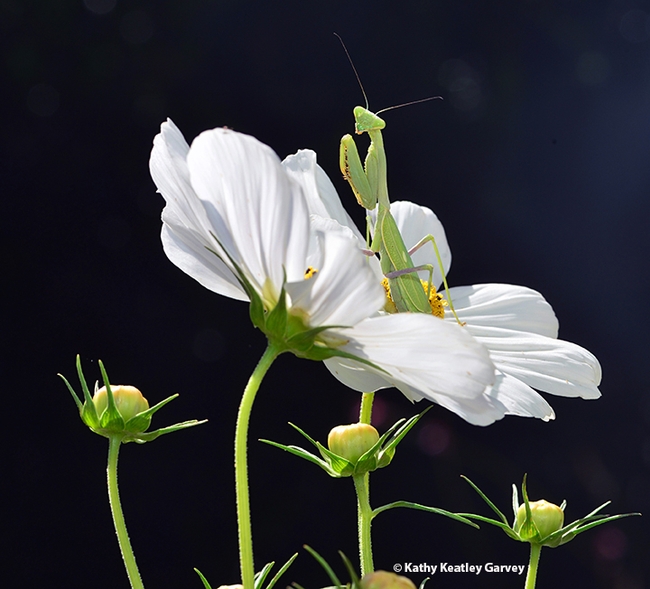- Author: Kathy Keatley Garvey
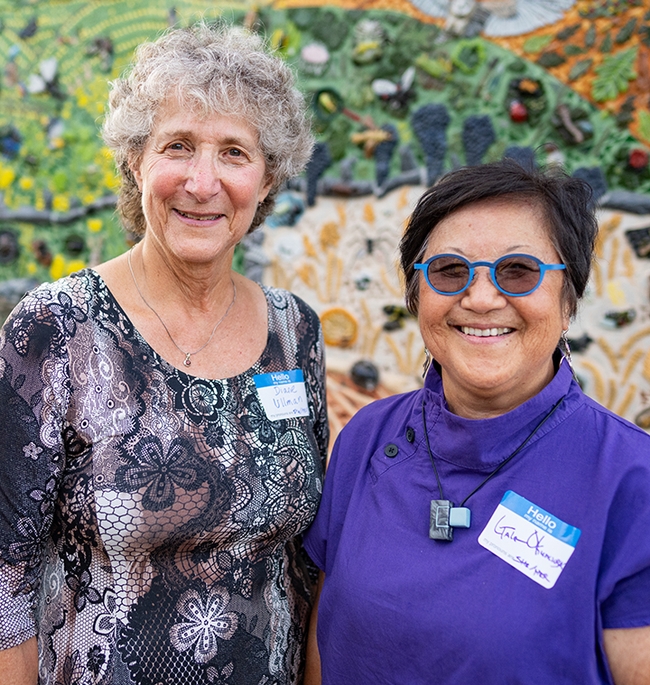
The 10 x 6-foot mural, which graces an outer wall of the Matthiasson Winery on Dry Creek Road, Napa, depicts more than 80 arthropods (insects, spiders and centipedes), several bird species, mammals (bobcat, deer, rabbits, squirrels, a pocket gopher), a gopher snake, mycorrhizal fungi and even earthworms, according to the three project leaders, UC Davis distinguished professor Diane Ullman and assistant professor Emily Meineke, both of the Department of Entomology and Nematology, and retired lecturer Gale Okumura of the Department of Design.
The project is the culmination of a spring quarter class, Entomology 001, “Art, Science and the World of Insects,” taught by Professors Ullman and Meineke. Ullman, founding co-director of the UC Davis Art/Science Fusion Program, described the project as “a collaboration between students and instructors in ENT 001; community members from Davis, Woodland, and Napa, and Matthiasson Winery; and the UC Davis Art/Science Fusion Program."
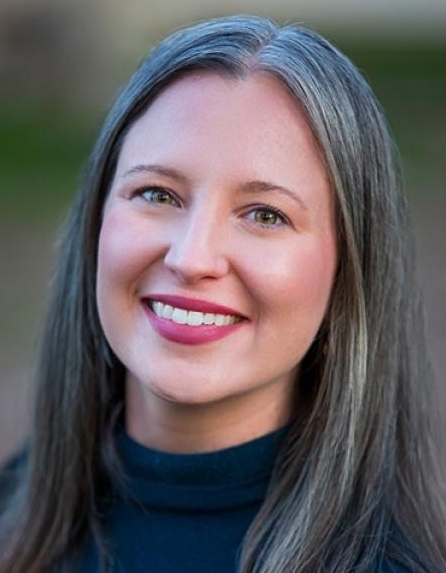
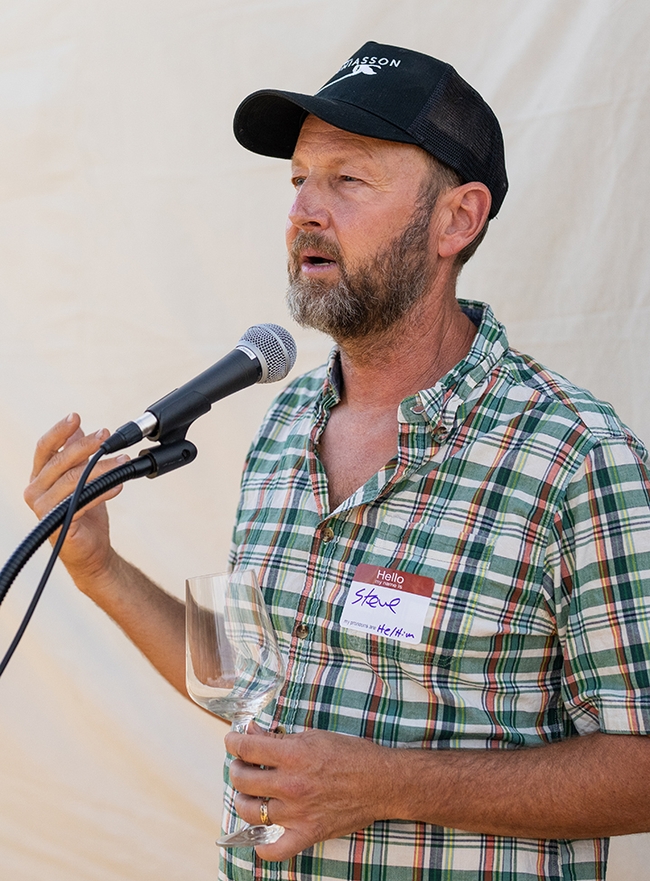
Praising the Arts/Science Fusion Program, the chancellor said the program "helps advance some of UC Davis' key goals, which are outlined in the university's 10-year strategic plan, titled 'To Boldly Go.' That first goal is to provide an educational experience that prepares all our students to address the needs and challenges of a diverse and changing world. The type of course that produced this mural helps advance this goal, by connecting art and science to enhance student learning in a truly innovative way. Another key goal is for UC Davis to be a role model for diversity. This program's strategy for teaching always includes community engagement, which attracts diverse students and fosters inclusivity through hands-on learning and collaborative teamwork. I also appreciate how the Arts/Science Fusion Program fosters community engagement."
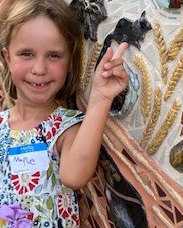
Ullman noted that the general education class, "Art, Science and the World of Insects," was founded in 1996. It's been taught ever year since, "attracting students from every major offered on the UC Davis campus," she said.
The course--"taught with the notion that patterns, harmonies, symbols, and perceptions are shared across borders and disciplines--creates accessibility and inclusion for people that would otherwise fear science, or fear art," Ullman told the crowd. "Not only does this paradigm provide a new and innovative classroom learning experience, it creates collaborations between different kinds of students and the community."
The concept of an art/science paradigm "opened the door for students and community members to interpret the scientific endeavors of the campus and science of entomology," said Ullman, praising the College of Agricultural and Environmental Sciences "that supports this innovative method of teaching and extending knowledge to the public."
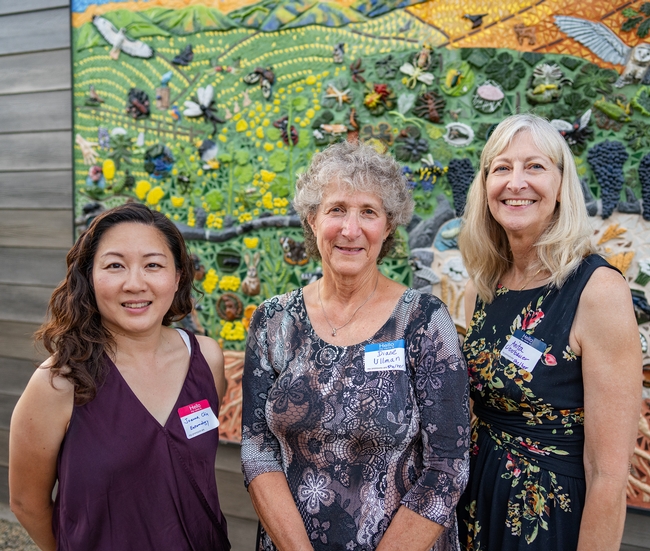
After advancing from research to a primary design, "the next step was to translate our research into visual narratives using design principles we learned from Gale," Ullman said. "With our designs in hand, the process of fabricating the artwork from clay began. Clay is a rich material with great memory, coming from the earth near Davis. In our classroom, every piece is used, recycled and carried forward."
"Once all the pieces of have been sculpted, glazed and fired in a kiln, assembly of the mosaic begins," Ullman related. "Everyone, students and community members contributed to assembly and grouting of the mosaic—truly a mosaic of human intention, creativity and will. We mixed our own grout and each color is custom designed after experimentation and consideration. Most artists would ask for 6 months to a year to complete a project of this size and scope. We completed the process in a mere 10 weeks, the scope of a quarter at UC Davis."
Ullman said that the 83 UC Davis students involved in the project "worked hard, learned about entomology, and the interactions between insects and people."
Meineke, an urban landscape entomologist, was unable to attend the Aug. 16th unveiling. Meineke and her husband Joe Kwon just "brought our newest Aggie, Genevieve Se Hwa Kwon into the world," Ullman told the gathering.
In a joint statement, Ullman and Meineke related that The Secret Life of Vineyards was designed to reflect the ecosystem within and around an organic vineyards as it progresses from early spring to harvest. A Cabernet Sauvignon vine is the centerpiece of the mural, shown from the first bud in the spring to harvest time in the autumn...The work is an ode to the importance of biodiversity and balance in the ecosystem in which wine vines are grown and reflects the passion of the Matthiasson Winery for sustainable viticulture.”
The professors credited artist Amanda Larson of Half Moon Bay "with the engineering and building of the hanging system, as well as the installation."
Resources:
- UC Davis Mural to Be Unveiled, news story, published Aug. 8, 2023, on the UC Davis Department of Entomology and Nematology website
- PowerPoint detailing the project from start to finish. This includes artist statements.
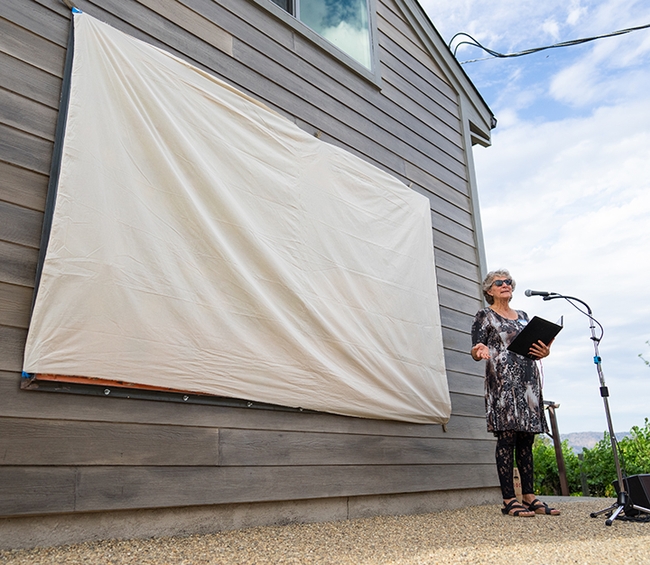

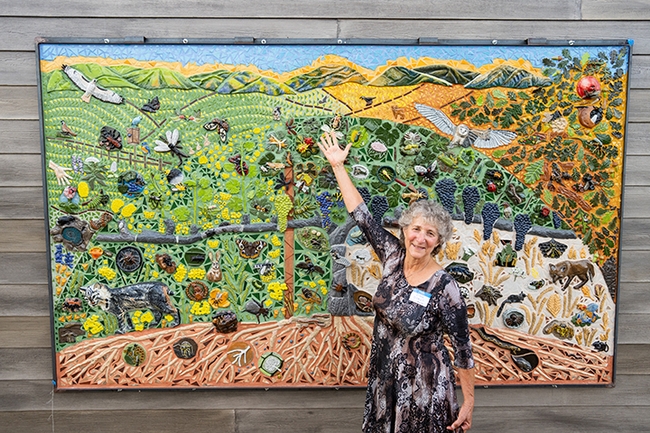
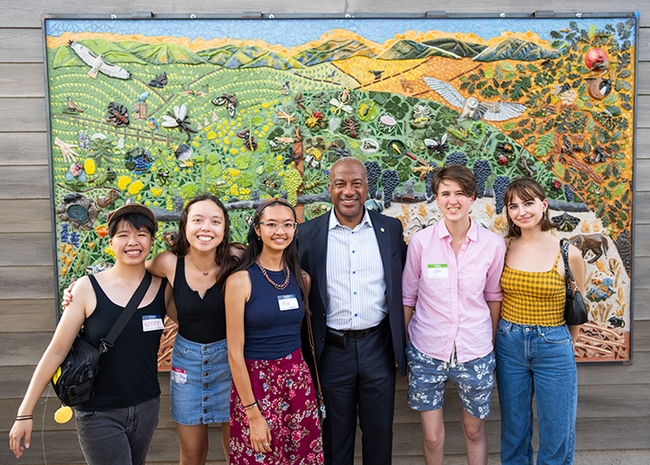
- Author: Kathy Keatley Garvey
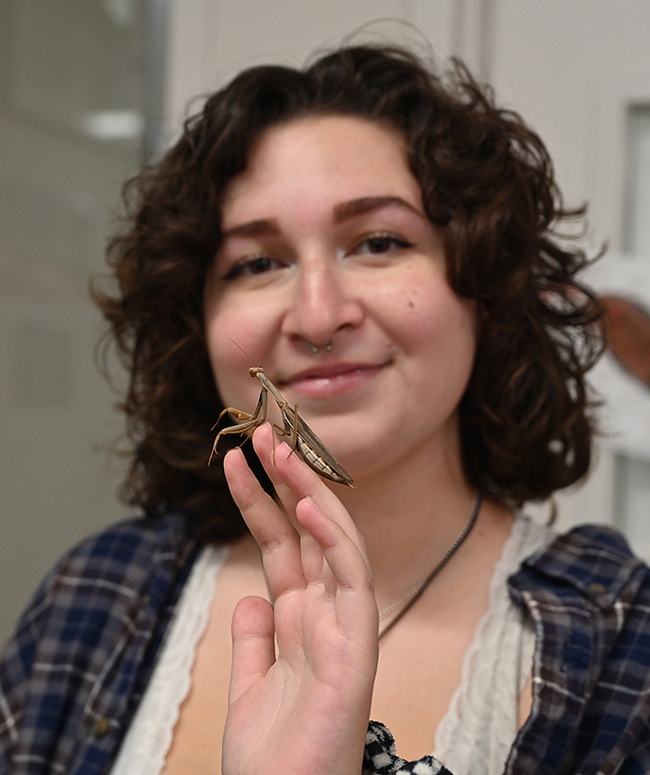
The open house, held from 1 to 4 p.m., Sunday, Aug. 27, drew guests of all ages.
Tabatha Yang, the Bohart Museum's education and outreach coordinator, wore a green mantis costume to greet guests and show them the Madagascar hissing cockroaches and stick insects in the live petting zoo.
UC Davis alumnus Kevin Murakoshi of Davis arrived to gift the museum with intricate origami mantises that he crafted from "mantis-green" paper--one sheet per mantis. Murakoshi, a former UC Davis employee (computer research specialist) is the principal solutions architect at Amazon Web Services.
Photographer Ian Alexander Levin of Sacramento displayed his enlarged images of mantises, including one of a mantis eating a bee that drew "oohs" and "aahs." He owns a child day care center in Sacramento and likes to share his finds in the "Critter Corner" of the center. Levin is the administrator of the Facebook page, SacraMantis.
Skylar Primavera, who studied praying mantises while attending UC San Barbara (bachelor's degree in biology, 2020) displayed a live mantis as well as life-cycle models (ootheca to the adult), and answered questions about the predatory insect.
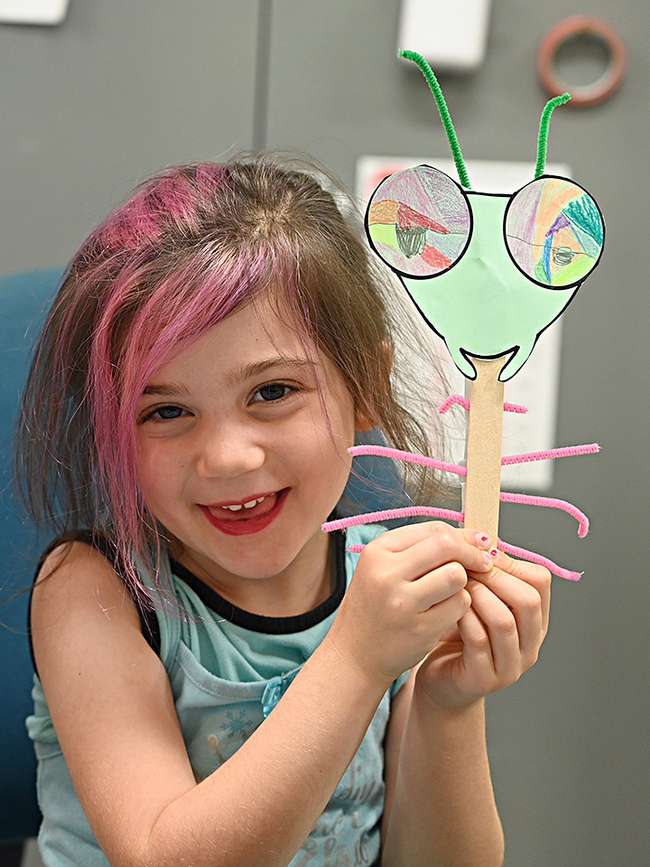
Melody Ruiz, a third-year entomology student, coordinated and staffed the family arts-and-crafts table, featuring "Mantis on a Stick." Using a green paper cutout of a mantis head attached to a popsicle stick, the budding artists colored the compound eyes and added pipe cleaners and other decorations as finishing touches.
Lynn Kimsey, director of the Bohart Museum, and Brennen Dyer, collections manager, welcomed the crowd and answered questions. The Lepidoptera crew of Jeff Smith (curator of the Lepidoptera collection), Greg Kareofelas and Brittany Kohler showed guests assorted butterfly specimens collected world-wide.
A computer screen showcased the work of UC Davis doctoral alumnus Alex Wild, curator of entomology at the University of Texas, Austin, and Kathy Keatley Garvey, communications specialist, UC Davis Department of Entomology and Nematology.
Guests viewed display drawers of both native and non-native mantises. At least 9 species of mantises in California, according to one display.
Five are native:
- The Arizona or bordered mantid (Stagmomantis limbata)
- Bistanta mexicana
- California mantid (Stagmomantis wheeleri=S. californica)
- Litaneutria ocularis=Litaneutria obscura
- Small gray mantid (Litaneutria pacfica)
Four are introduced:
- Chinese mantid (Tenodera sinensis)
- European mantid (Mantis religiosa)
- Mediterranean mantid (Iris oratoria)
- South African mantid (Miomantis caffra)
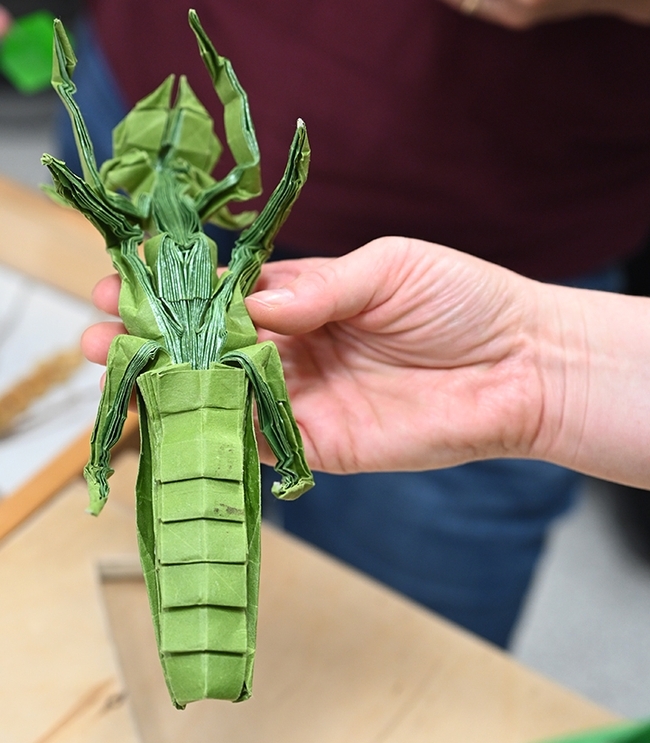
The Bohart Museum, located in Room 1124 of the Academic Surge Building, 455 Crocker Lane, UC Davis, houses a global collection of eight million insect specimens, plus a live petting zoo and an insect-themed gift shop, stocked with t-shirts, hoodies, books, posters, jewelry, collecting equipment and more.
Professor and renowned entomologist Richard Bohart (1913-2007), a member of the UC Davis Department of Entomology (now the Department of Entomology and Nematology) faculty for more than 50 years, founded the museum in 1946.

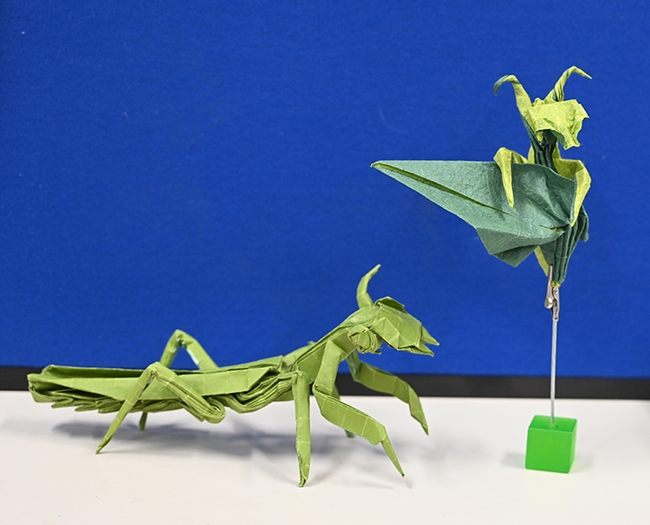
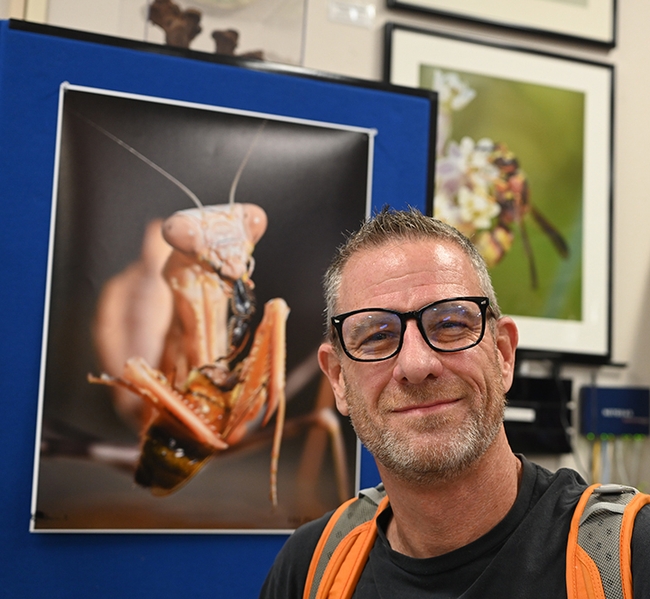
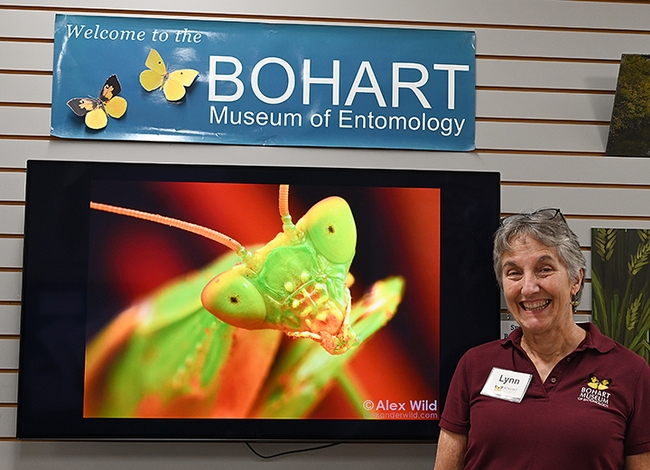
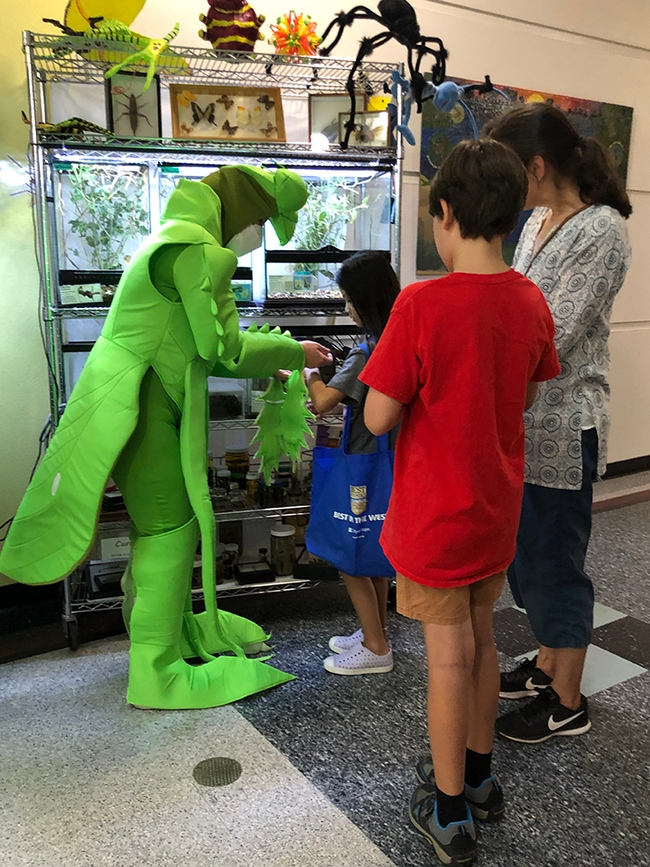
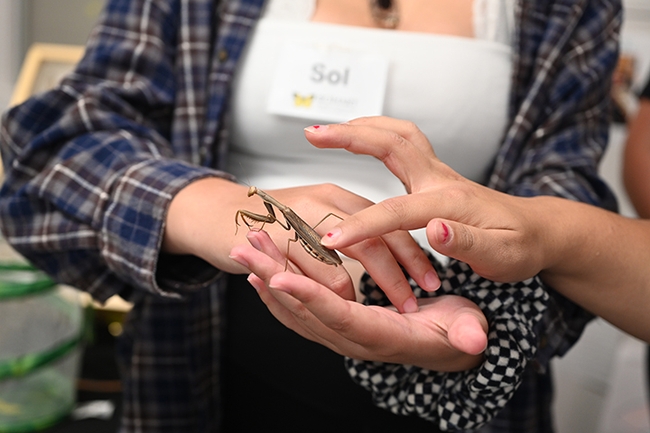
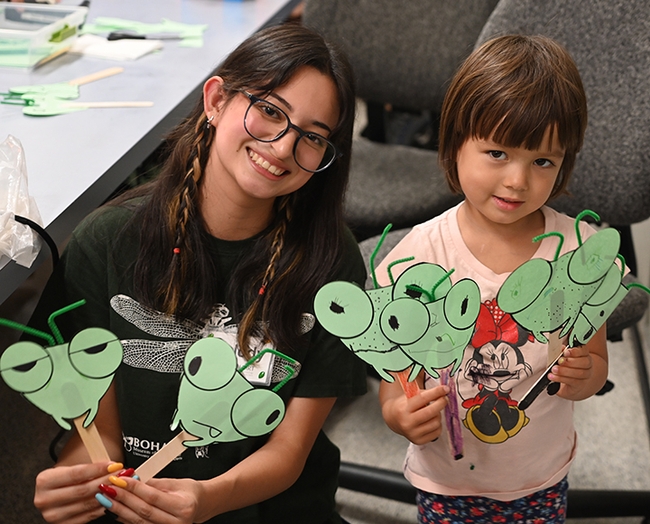
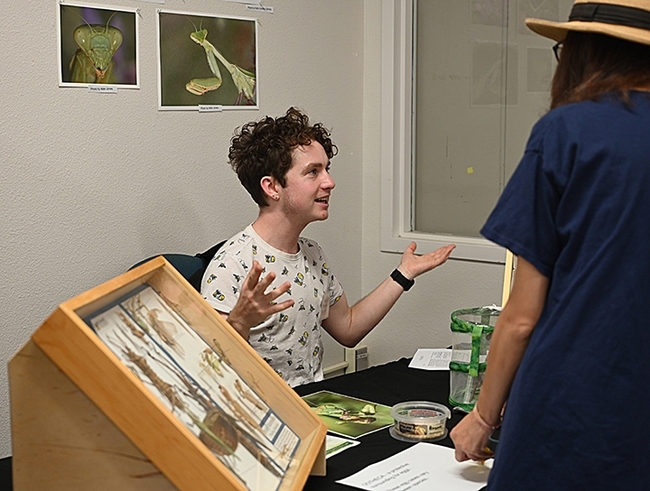
- Author: Kathy Keatley Garvey
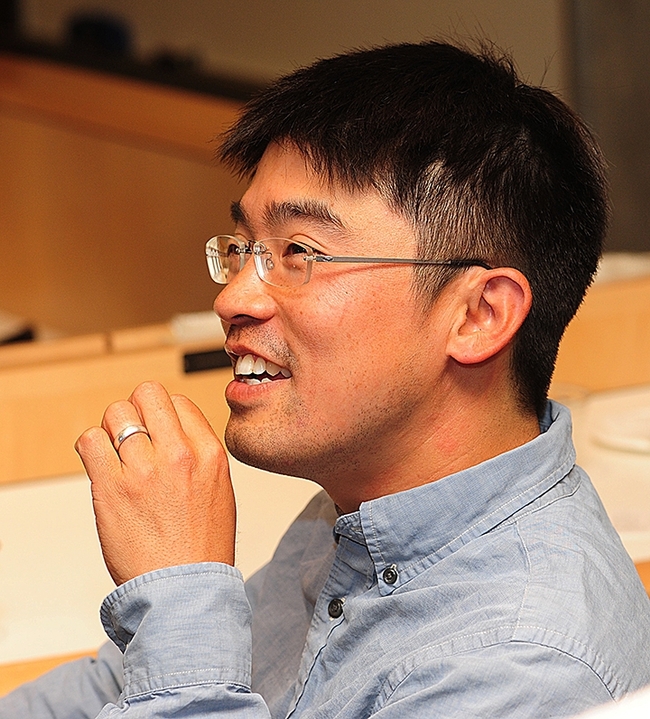
In a congratulatory letter to him, Jean-Pierre Delplanque, vice provost and dean of Graduate Studies, wrote: "Your program selected you for this award due to your excellent service to your graduate program, as well as your positive impact on graduate students and your colleagues. We thank you for your investment in advising and mentoring graduate students and contribution to their success."
The nomination letter included: "What sets Louie apart are these three qualities: (1) He is honest to the unique needs and interests of each student. He knows that the diversity of ideas and perspectives fuels scientific progress. He respects each student's unique perspective and interests He gives his students opportunities to view themselves as intellectual colleagues and contributors. (2) He facilitates intellectual independence in his drive to help students transition from being consumers of knowledge to becoming producers of knowledge. (3) He learns from his students. He knows that mentorship is a two-way street."
Another excerpt from the nomination letter: "It is unusual and truly special, to find a mentor that perfectly balances generous, unwavering support with a deep appreciation for his students' independence. His supportive advising style, almost paradoxically, allows his students to develop a high degree of independence and self-motivation."
Professor Yang is one of seven faculty members from the College of Agricultural and Environmental Sciences singled out for the award. The other recipients are:
- Cort Anastasio, Agricultural and Environmental Chemistry
- Brian Bailey, Horticulture and Agronomy
- Katrina Jessoe, Agricultural & Resource Economics
- Heather Knych, Pharmacology and Toxicology
- Alessandro Ossola, Environmental Policy and Management
- Caroline Slupsky, Nutritional Biology
The 2023 award recipients also include 14 from the College of Letters and Sciences; 5 from the College of Biological Sciences, 6 from the College of Engineering, and one from the School of Medicine. (See news story)
Yang, who received his bachelor's degree in ecology and evolution from Cornell University in 1999, and his doctorate in population biology from UC Davis in 2006, joined the UC Davis faculty in 2009.
He co-directs and mentors students in the Research Scholars Program in Insect Biology (RSPIB), a campuswide program that he and Professors Jay Rosenheim (now a UC Davis distinguished professor) and Joanna Chiu (now chair of the Department of Entomology and Nematology) co-founded in 2011 to help students learn cutting-edge research through close mentoring relationships with faculty. The program crosses numerous biological fields, including population biology; behavior and ecology; biodiversity and evolutionary ecology; agroecology; genetics and molecular biology; biochemistry and physiology; entomology; and cell biology. The goal: to provide academically strong and highly motivated undergraduates with a multi-year research experience that cultivates skills that will prepare them for a career in biological research.
Professor Yang is the second recipient of the campuswide award from the Department of Entomology and Nematology. Last year Rosenheim, who specializes in insect ecology, received the honor.
Highly honored for his advising and mentoring, Yang earlier received the 2023 Distinction in Student Mentoring Award from the Pacific Branch of the Entomological Society of America (PBESA), which encompasses 11 Western states, parts of Canada and Mexico, and U.S. territories. He was praised for "being a strong advocate for his students and fostering creative and critical thinking." His other honors include the 2017 Eleanor and Harry Walker Academic Advising Award from CA&ES. In 2018, he received the regional (Pacific Region 9, California, Nevada and Hawaii) Outstanding Faculty Academic Advisor from NACADA, also known as the Global Community for Academic Advising, and then went on to win NACADA's international award for the Outstanding Faculty Academic Advising Award.
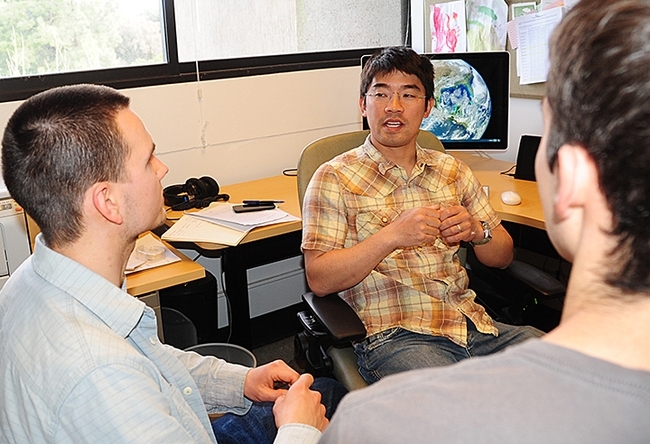
- Author: Kathy Keatley Garvey
It's BYOM at the Bohart Museum of Entomology today (Sunday, Aug. 27).
That's “Bring Your Own Mantis.”
The open house, themed "Praying Mantises," is set from 1 to 4 p.m., in Room 1124 of the Academic Surge Building, 455 Crocker Lane. It is free and family friendly.
“Bring a live praying mantis to show and share--and to bring back home--and have your name entered into a raffle for a Bohart t-shirt of your choice!” announced Tabatha Yang, education and outreach coordinator. “The mantis can be a purchased pet or one you found outside.”
The Bohart Museum of Entomology, founded in 1946 and directed by UC Davis distinguished professor LynnKimsey, houses a global collection of eight million insect specimens; a live petting zoo, including Madagascar hissing cockroaches, stick insects and tarantulas; and an insect-themed gift shop, stocked with books, posters, collecting equipment, t-shirts, hoodies, jewelry and more. More information is available on the website https://bohart.ucdavis.edu/ or email bmuseum@ucdavis.edu.

- Author: Kathy Keatley Garvey
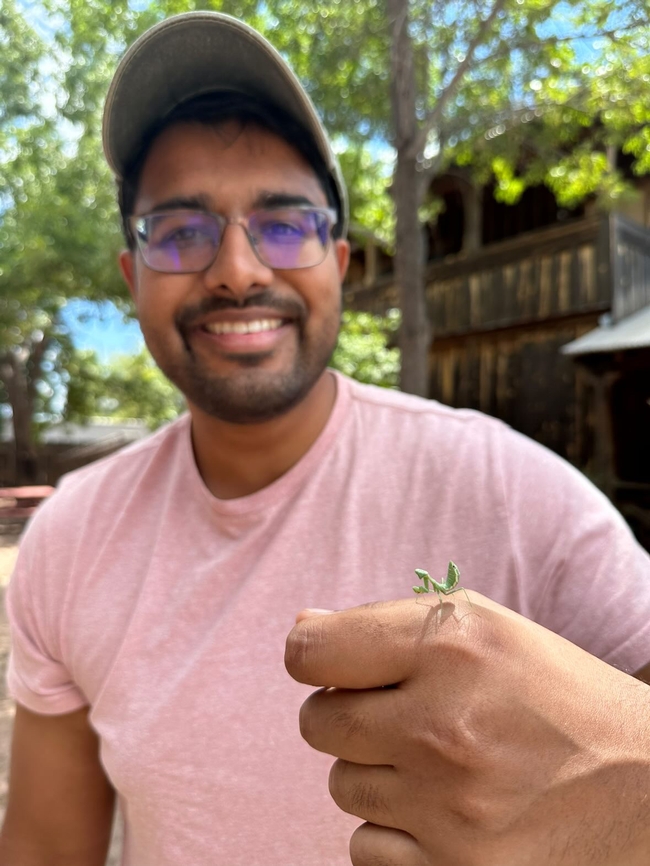
The Bohart Museum of Entomology is hosting an open house, themed "Praying Mantises," on Sunday, Aug. 27 in Room 1124 of the Academic Surge Building, 455 Crocker Lane, UC Davis campus. It is free and family friendly.
When asked what's fascinating about praying mantises, Lohit Garikipati, UC Davis entomology graduate (bachelor of science degree, 2019) wrapping up his master's degree with biologist Christopher Oufiero at Towson University,Towson, MD, said:
"What's fascinating about them... hard to pick just one thing! If I had to choose it would be their general awareness about the environment they are in. They are always watching, always waiting, and adjust their posture, behavior, and movement based on various environmental stimuli. They engage in some of the most interesting predatory behaviors; pouncing, lunging, spearing (yes, spearing!) and sometimes throwing themselves off of perches to secure potential prey. Few flightless predators can catch prey out of the air on the wing but many specialized species are more than capable of doing so. They are the insect equivalent of cats in many ways, but with some weird adaptations!"
Garikipati, who participated in many Bohart Museum open houses while a student at UC Davis, won't be at the open house on Aug. 27 but he will be their spirit. He plans to obtain his doctorate in entomology.
According to Kris Anderson of Las Vegas, an alumnus of Cornell University (master's degree in entomology) and author of Praying Mantises of the United States and Canada: "There are just 28 species of Mantodea found within the United States and Canada, the 7 largest of which are invasive species from other parts of the globe."
Some myths about praying mantises, as related by Anderson in his book, available on Amazon:
Myth: "Mantises sway back and forth while crawling to imitate vegetation blowing in the wind."
Truth: "The peering movement of mantises, demonstrated by the swaying back and forth of their body while ambulating or preparing to leap/take flight, is a behavioral adaptation to gain depth perception of their surroundings and has nothing to do with mimicry. Mantises blend into their environment by remaining motionless against a substrate that they morphologically resemble—not by moving. Peering movements causes the retinal images of nearby objects to be displaced more quickly than those of more distant objects, thus allowing the mantis to gain depth perception of its environment as it navigates forward."
Myth: "Mantises grab insects and immediately bite the neck/head to quickly kill their prey."
Truth: "The spinose forelegs of praying mantises are used to hold onto and prevent their prey from escaping. Once secured in their grip, the mantis will pull the prey forward and begin to meticulously chew upon whatever body part of the prey item is closest to their mouth—be it a leg, a wing, the thorax, abdomen, or head. No specific body region is exclusively targeted and the prey is always eaten alive, bit by bit, dying a slow death."
Myth: "Female mantises cannibalize the males while mating."
Truth: "With over 2,400 species of Mantodea worldwide, only a small fraction of species regularly engage in sexual cannibalism. Most do not. Of those that engage in this practice, the occurrence is not inevitable, as males typically escape and may mate with other partners."
The Bohart Museum, founded in 1946 and directed by UC Davis distinguished professor Lynn Kimsey, houses a global collection of eight million insect specimens, plus a live insect petting zoo (Madagascar hissing cockroaches, stick insects and tarantulas), and an insect-themed gift shop, stocked with t-shirts, hoodies, books, posters, jewelry and more.
The Bohart Museum is planning two other open houses this fall:
Saturday, Sept. 23: Household Vampires
Saturday, Nov. 4: Monarchs
All open houses are free and family friendly. At each event, the focus is on a special theme, but there's also a family arts-and-crafts activity, announced Tabatha Yang, education and outreach coordinator.
